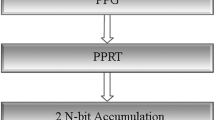Abstract
Heretofore many All-One-Polynomials (AOP) based multipliers are proposed over GF(2m). Previously proposed multipliers have serial input structure and also suffer from a long critical path delay. In this paper we improve AOP based multipliers by reducing the critical path delay and changing the input structure to parallel. Initially, we modify the wiring of the previously proposed AOP based multipliers. This approach reduces the critical path delay from O(m) to O(log m). In order to further reduce this delay from O(log m) to O(1) the pipeline technique is utilized. The efficiency of the proposed architectures is evaluated based on criteria of time (latency, critical path) and space complexity (gate-latch number).




Similar content being viewed by others
References
Menezes, A. J., van Oorschot, P. C., & Vanstone, S. A. (1997). Handbook of applied cryptography. Boca Raton: CRC Press.
Miller, V.S. (1986). Uses of elliptic curves in cryptography. In H. C. Williams, (Ed.), Advances in Cryptology – CRYPTO ’85, volume 218 of LNCS, (pp 417–428). Springer.
Kim, H. S., & Lee, S. W. (2007). LFSR multipliers over GF(2 m) defined by all-one polynomial. Integration, the VLSI Journal, 40(4), 473–478.
Nikooghadam, M., Zakerolhosseini, A., & Ebrahimi Moghaddam, M. (2010). Efficient utilization of elliptic curve cryptosystem for hierarchical access control. Journal of System and Software, 83(10), 1917–1929.
Nikooghadam, M., & Zakerolhosseini, A. (2009). An efficient blind signature scheme based on the elliptic curve discrete logarithm problem. The ISC Int’l Journal of Information Security, 1(2), 125–131.
Nikooghadam, M., Safaei, F., Zakerolhosseini, A. (2010). An efficient key management scheme for mobile agents in distributed networks, 1st International Conference on Parallel, Distributed and Grid Computing, IEEE, (PDGC), 32, 28–30.
McEliece, R. J. (1987). Finite fields for computer scientists and engineers. New York: Kluwer Academic Publishers.
Koblitz, N. (1987). Elliptic curve cryptosystems. Mathematics of Computation, 48(177), 203–209.
Nandi, S., Kar, B. K., & Chaudhuri, P. P. (1994). Theory and applications of cellular automata in cryptography. IEEE Transaction on Computers, 43(12), 1346–1357.
Mastrovito, E.D. (1991). VLSI architectures for computations in galois fields, Phd Thesis, Linkoping University.
Shparlinski, I.E. (1999). Finite fields: theory and computation. Kluwer Academic Publishers.
García-Martínez, M.A., Posada-Gómez, R., Luna, G.M. (2005). FPGA Implementation of an Efficient Multiplier over Finite Fields GF(2m). IEEE Proc. of the 2005 Int. Conf. on Reconfigurable Comput. and FPGAs. 68–82.
Kitsos, P., Theodoridis, G., & Koufopavlou, O. (2003). An efficient reconfigurable multiplier architecture for Galois field GF(2m). Microelectronics Journal, 34(10), 975–980.
Koc, C. K., & Sunar, B. (1998). Low-complexity bit-parallel canonical and normal basis multipliers for a class of finite fields. IEEE Transaction on Computers, 47(3), 353–356.
Selimis, G. N., Fournaris, A. P., Michail, H. E., & Koufopavlou, O. (2009). Improved throughput bit-serial multiplier for GF(2m) fields. Integration, the VLSI Journal, 42(2), 217–226.
Zakerolhosseini, A., Nikooghadam, M. (2012). Low-power and high-speed design of a versatile bit-serial multiplier in finite fields GF(2m), NTEGRATION ,the VLSI journal, http://dx.doi.org/10.1016/j.vlsi.2012.03.001
Li, H., & Zhang, C. N. (2002). Efficient cellular automata based versatile multiplier for GF(2m). Journal of Information Science and Engineering, 18(4), 479–488.
Talapatra, S., Rahaman, H., & Mathew, J. (2010). Low complexity digit serial systolic Montgomery multipliers for special class of GF(2m). IEEE Transactions on Very Large Scale Integration (VLSI) Systems, 18(5), 847–852.
Jeon, J. C., Kim, H. S., Lee, H. M., & Yoo, K. Y. (2002). Bit-serial AB2 multiplier using modified inner product. Journal of Information Science and Engineering, 18(4), 507–518.
Jeon, J. C., Kim, K. W., & Yoo, K. Y. (2006). A novel approach for bit-serial AB 2 multiplication in finite fields GF(2m). Computers & Mathematics with Applications, 51(6–7), 1103–1112.
Fenn, S. T. J., Parker, M. G., Benaissa, M., & Tayler, D. (1997). Bit-serial multiplication in GF(2m) using irreducible all-one polynomial. IEE Proceedings - Computers and Digital Techniques, 144(6), 391–393.
Kim, H. S., & Yoo, K. Y. (2004). AOP arithmetic architectures over GF(2m). Applied Mathematics and Computation, 158(1), 7–18.
Hwang, Y.H., Sim, S.G., Lee, P.J. (2004). Bit-serial Multipliers for Exponentiation and Division in GF(2m) using Irreducible AOP, ICCSA, 442–450, Springer
Itoh, T., & Tsujii, S. (1989). Structure of parallel multipliers for a class of fields GF(2 m). Information and Computation, 83(1), 21–40.
Rodriguez-Henriquez, F., & Koc, C. K. (2003). Parallel multipliers based on special irreducible pentanomials. IEEE Transactions on Computers, 52(12), 1533–1542.
Sunar, B., & Koc, C. K. (1999). Mastrovito multiplier for all trinomials. IEEE Transactions on Computers, 48(5), 522–527.
Song, L., & Parhi, K. (1998). Low-energy digit-serial/parallel finite field multipliers. Journal of VLSI Signal Processing, 19(2), 149–166.
Fournaris, A. P., & Koufopavlou, O. (2008). Versatile multiplier architectures in GF(2k) fields using the Montgomery multiplication algorithm. Integration, the VLSI Journal, 41(3), 371–384.
Hutter, M., Großschadl, J., Kamendje, G. (2003). A versatile and scalable digit-serial/parallel multiplier architecture for finite fields GF(2m). IEEE Proc. of the 4th Int. Conf. on Inform. Technology: Coding and Computing, 692–700.
Wang, C. L., & Lin, J. L. (1991). Systolic array implementation of multipliers for finite fields GF(2m)”. IEEE Transactions on Circuits and Systems, 38(7), 796–800.
Tsai, W. C., & Wang, S. J. (2000). Two systolic architectures for multiplication in GF(2m). IEE Proceedings - Computers and Digital Techniques, 147(6), 375–382.
Guo, J. H., & Wang, C. L. (1998). Digit-serial systolic multiplier for finite fields GF(2m). IEE Proceedings - Computers and Digital Techniques, 145(2), 143–148.
Lee, C. Y., Lu, E. H., & Lee, J. Y. (2001). Bit-parallel systolic multipliers for GF(2m) fields defined by all-one and equally spaced polynomials. IEEE Transaction on Computers, 50(5), 385–393.
Sudhakar, M., Kamala, R.V., Srinivas, M.B. (2007). A Unified, Reconfigurable Architecture for Montgomery Multiplication in Finite Fields GF(p) and GF(2n), 20th Int. Conf. on VLSI Design (VLSID’07), 68–82.
Morales-Sandoval, M., Feregrino-Uribe, C., & Kitsos, P. (2011). Bit-serial and digit-serial GF(2 m)Montgomery multipliers using linear feedback shift registers. Computers & Digital Techniques, IET, 5(2), 86–94.
Author information
Authors and Affiliations
Corresponding author
Rights and permissions
About this article
Cite this article
Nikooghadam, M., Zakerolhosseini, A. Utilization of Pipeline Technique in AOP Based Multipliers with Parallel Inputs. J Sign Process Syst 72, 57–62 (2013). https://doi.org/10.1007/s11265-012-0702-6
Received:
Revised:
Accepted:
Published:
Issue Date:
DOI: https://doi.org/10.1007/s11265-012-0702-6




